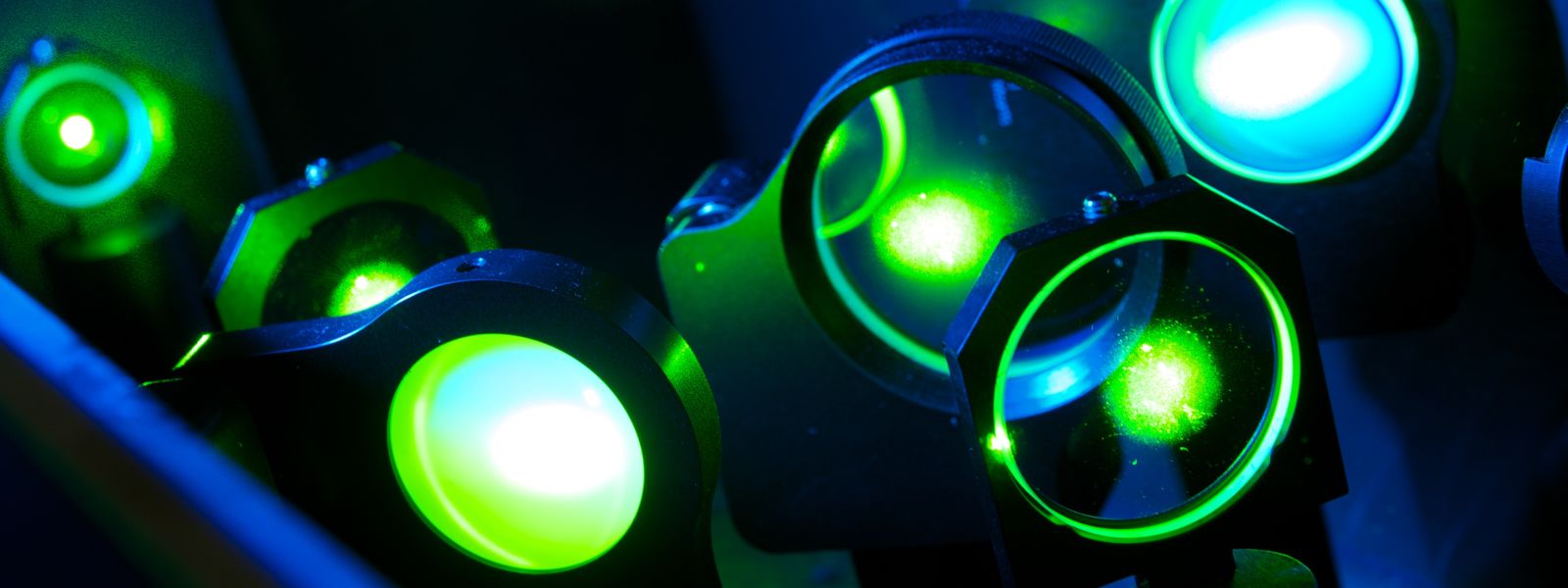Rolling the polarization dice: Spontaneous formation of non-trivial polarization structures in a laser
Researchers at the Department of Physics under the lead of Thorsten Ackemann with visiting researchers from the University of Montpellier and the University of Cordoba have demonstrated the spontaneous emergence of laser beams with spatially non-uniform polarization.
October 2017
A Golden (Binary) Future for Gravitational Wave Astronomy
On 17 August, 2017, the two LIGO detectors, together with Virgo, 'heard' the inspiral and merger of a pair of neutron stars for the very first time, this merger having taken place 'just' 40 million parsecs away. Moreover, this event was seen in the electromagnetic spectrum, from gamma rays to infrared light.
October 2017
Promotion
The Department congratulates Keith Mathieson on his promotion to Professor.
October 2017
Building the Quantum Space Internet
Strathclyde physics research has been recognised in a BBC article 'How do you build the next-generation internet?'
October 2017
Congratulations to the winners of the 2017 Nobel Prize in Physics for Gravitational Wave Research
Prof. Nicholas Lockerbie and the Department of Physics congratulate the winners of the 2017 Nobel Prize in Physics: Rainer Weiss (MIT), Barry C. Barish (Caltech) and Kip S.Thorne (Caltech).
October 2017
Neuromorphic Photonics Research at the Institute of Photonics highlighted in Laser Focus World
Recent research in Dr Antonio Hurtado’s group at Strathclyde’s Institute of Photonics in artificial photonic neurons has been highlighted in an article in the latest issue of the magazine Laser Focus World.
August 2017
Breakthrough Technique to Generate Brightest Electron Beams in the World
A novel study, involving SCAPA Professors Bernhard Hidding and Zheng-Ming Sheng, proposes electron beams with orders of magnitude better brightness than state-of-the-art.
July 2017
Physics Lecturer wins Tom Gibson Award
Congratulations to Brian Patton from the Department of Physics who is the winner of the biennial Tom Gibson Award. The award is made to recognise the outstanding achievement of a young researcher.
June 2017
Strathclyde develops world’s highest gain high-power laser amplifier
Researchers at Strathclyde have demonstrated the feasibility of using plasma to amplify short laser pulses by a 'gain' of more than eight orders of magnitude – likened to amplifying the sound of rustling leaves to that of a jumbo jet - in just two mm of plasma.
May 2017
Promotions
The Department congratulates Alison Yao, Ben Hourahine and Michael Strain on their promotion to Senior Lecturer.
May 2017
Space radiation reproduced in the lab for better, safer missions
Man-made space radiation has been produced in research led by the University of Strathclyde, which could help to make space exploration safer, more reliable and more extensive.
May 2017
We acquire one of the world’s most powerful lasers
One of the world’s most powerful lasers – capable of bursts of light equivalent to twenty times all the power consumed on Earth, captured in fraction of a second – has been acquired by the University of Strathclyde.
May 2017
Promotions
The Department congratulates Neil Hunt on his promotion to Professor and David McKee on his promotion to Reader.
May 2017
12th FluoroFest International Workshop commemorates 40th Anniversary of the Founding of IBH, the Department’s first Spin-out Company
The Glasgow FluoroFest was attended by over 100 delegates from 14 countries, who networked with, and listened to a diverse lecture program delivered by world-renowned speakers, student flash talks, vibrant poster sessions and experienced hands-on instrument training. Papers from the workshop will be published in a special issue of the IoP journal Methods and Applications in Fluorescence.
April 2017
Strathclyde gains full membership of The Cockcroft Institute
The University of Strathclyde is delighted to announce its full membership of the Cockcroft Institute (CI). The CI, a national centre for particle accelerator R&D in the UK, is a partnership between the Universities of Lancaster, Liverpool, Manchester, Strathclyde, and the Science & Technology Facilities Council (STFC).
April 2017
Where does laser energy go after being fired into plasma?
An outstanding conundrum on what happens to the laser energy after beams are fired into plasma has been solved in newly-published research at the University of Strathclyde.
March 2017
Ultra-Tight Light Pulses: Mode-Locked Spatial Solitons
The Strathclyde team led both the experimental realization and the theoretical confirmation of ultra-tight light pulses in the form of mode-locked spatial solitons.
March 2017
Strathclyde leads new project exploring and designing quantum dynamics
The Department of Physics at Strathclyde is leading a new research programme on "Designing out-of-equilibrium many-body quantum systems". This £5.8M project to run over five years involves highly interlinked experimental and theoretical research at the Universities of Strathclyde, Cambridge and Oxford.
February 2017
Physics awards for Strathclyders
Three physics researchers at the University of Strathclyde have received an international award for their work on the ground-breaking discovery of gravitational waves.
February 2017
Strathclyde Professor appointed to Editorial Board of Physical Review Letters
Gian-Luca Oppo of the Department of Physics has been appointed by the American Physical Society to the editorial board of Physical Review Letters from 16 January 2017 to 15 January 2020.
January 2017
ColOpt – Collective Effects and optomechanics in ultracold matter
A new European Training Network will train early-stage researchers in fundamental science and applications in the areas of cold atom and quantum physics, optical technologies and complexity science to promote European competitiveness in emergent quantum technologies.
January 2017
Light Source Discovery 'challenges basic assumption' of Physics
A widely-held understanding of electromagnetic radiation has been challenged in newly published research led at the University of Strathclyde.
January 2017
